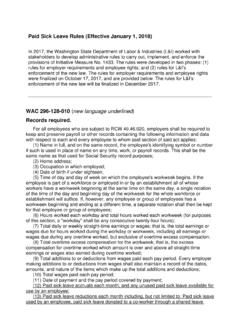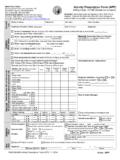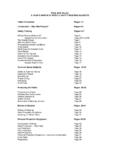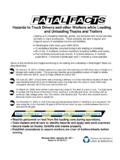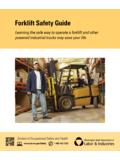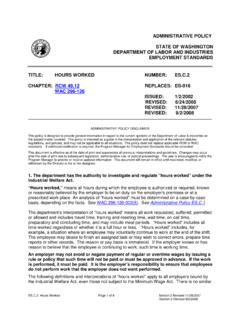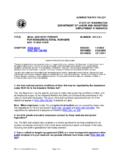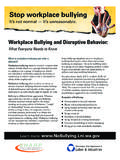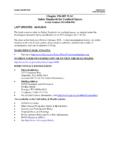Transcription of Prevent Carbon Monoxide Poisoning from Forklifts
1 Prevent Carbon Monoxide Poisoning from Forklifts Success strategies for electric and fuel-driven forklift fleets SHARP. Safety & Health Assessment &. Research for Prevention . Contents Page 1. Carbon Monoxide (CO) 2. What are the toxic effects?.. 2. What sources generate CO?.. 2. Why is it dangerous to use fuel-driven Forklifts indoors?.. 3. Economic Impact of Carbon Monoxide (CO) 5. Cost of CO workers' compensation claims in Washington 5. Be aware! CO claims were reviewed and the following factors were commonly associated with CO Poisoning caused by 5. Controlled atmosphere storage 6. Economic impact case 7. CO Prevention Strategies You Need to 11. Strategy 1. Electric Forklifts Facts & Company 13. Key points to consider with electric Battery life and Battery Using electric Forklifts : Two company Large company - Profile # Medium-size company - Profile # Strategy 2.
2 Fuel-Driven Forklifts Control CO & Save Fuel 19. Engine Why do low CO emissions save on fuel?..19. Carbon Monoxide emissions Fuel-driven lifts: The latest in catalytic When should catalytic converters be used?..21. What kinds of catalytic converters are available?..21. Do catalytic converters eliminate all CO in exhaust gas?..21. Keep these points in mind about catalytic i Contents Page Strategy 2. Fuel-Driven Forklifts Continued Building ventilation and administrative Employee training and hazard Who should be trained?..25. What should the training cover?..25. 27. Regulations and 29. Permissable exposure limits (PELs) for Carbon Helpful List of 30. Appendices A. Cost Analysis Worksheet of Electric and Fuel-Driven B. Environmental Protection Agency (EPA) Emission C.
3 Carbon Monoxide (CO) Employee Training Notes: WISHA refers to the Washington Industrial Safety and Health Act. DOSH is the Washington State Department of Labor & Industries' Division of Occupational Safety and Health. Unless otherwise indicated, statistics and examples in this document pertain to Washington State. ii Introduction Introduction Carbon Monoxide (CO) Poisoning from internal combustion Forklifts is common in Washington State. This document illustrates the health dangers to employees and the economic effects of CO Poisoning . Employers are encouraged to adopt a CO prevention plan using the strategies outlined in this publication. The strategies include: 1. Use of electric Forklifts 2. Control of CO and reduced fuel costs for combustion engine Forklifts Useful information included in this document includes: n Economic Impact of CO Poisonings n Case studies on recent company-wide poisonings n Electric Forklifts n Company experience with electric Forklifts n Forklift cost-comparison worksheet n Fuel-Driven Forklifts n Save fuel costs by reducing CO emissions n In-house emissions testing n New emission regulations and catalytic converter technology n Recommendations for CO monitoring n Employee Training Checklist The purpose of this document is to educate employers on the risks and costs of CO Poisoning .
4 Use this document to investigate whether electric lifts are affordable for your company. If you continue to operate fuel-driven lifts indoors, follow this document to design a comprehensive CO prevention strategy that prevents poisonings, uses the latest technology available, and is cost-effective. If you operate fuel-driven Forklifts indoors, you are strongly encouraged to: n Review the costs and benefits of electric Forklifts Save fuel costs and reduce CO Poisoning risk with a n comprehensive CO prevention strategy 1. Carbon Monoxide (CO) Poisoning Carbon Monoxide (CO) is odorless, tasteless, colorless, non-irritating and cannot be detected by any of the senses. Because it cannot be detected, employees can be exposed to very high levels without realizing there is a problem.
5 What are the toxic effects? Early symptoms of CO exposure are flu-like and nonspecific: headache, nausea, dizziness, visual disturbances, and rapid breathing. A person may feel weak and disoriented, making it difficult to escape the environment. Organs that are highly dependent on oxygen such as the brain and heart are essentially starved during CO Poisoning , and severe Poisoning can lead to unconsciousness, permanent brain injury and death. In pregnant women, CO can reach the fetus and cause harm. CO does not accumulate in the body. Once exposure has stopped and fresh air is inhaled, the lungs exhale CO and it is removed from the body. Breathing pure oxygen or use of a hyperbaric chamber (pure oxygen administered under pressure) can be administered to speed the removal of CO from the blood.
6 Technical Tip: CO is a chemical asphyxiant that when inhaled, binds tightly to hemoglobin in the blood forming carboxyhemoglobin (COHb). and preventing the blood from carrying oxygen. Medical providers may determine COHb blood levels in the course of treatment. COHb blood levels can also be used to estimate the amount of CO present in the air at the time of the Poisoning . What sources generate CO? Carbon Monoxide (CO) is produced by the incomplete combustion of Carbon -containing fuels. Sources that generate CO include: n Internal combustion engines, such as forklift engines powered by: n Gasoline n Liquefied petroleum gas (LPG, propane). n Diesel n Small gas- or propane-powered engines can generate CO and should never be used in enclosed spaces.
7 Examples include: n Area heaters n Pressure washers n Compressors n Generators n Floor buffers n Other fuel-burning power tools 2. Introduction Why is it dangerous to use fuel-driven Forklifts indoors? n Even low levels of CO can make your employees ill. n CO can accumulate rapidly in the environment. How much and how quickly depends on: n The number of Forklifts idling or operating n How well the engines are tuned n Length of time the Forklifts operate n How fast fresh air and ventilation dilute the CO. Forklifts that operate outside do not typically pose a threat for CO Poisoning because the exhaust is diluted into the ambient environment. Electric Forklifts do not emit Carbon Monoxide . 3. 4. Economic Impact of Carbon Monoxide (CO) Poisoning Workers' compensation claims data show that Forklifts are the most frequent source of occupational CO.
8 Poisoning in Washington State from 2000 2005 (154 out of 345 claims accepted for CO Poisoning or 45%). Economic Impact Cost of CO workers' compensation claims in Washington State The figure below shows the median costs for CO claims from 2000 to 2005, by the top 5 CO sources. Most workers' compensation claims incur medical-only costs; examples of these costs are emergency room treatment and medical bills. Claims for individuals who miss four or more days of work are described as compensable and these costs include all medical costs as well as time loss (kept-on-salary) benefits and disability benefits. Not only are forklift-related CO claims the most frequent; they are the most expensive. In 2000 2005, there were 137 medical-only CO claims caused by Forklifts with a median cost of $523 per claim (half of the 137 claims cost less than this amount and half cost more).
9 The 16 more serious, compensable, forklift-CO claims had median costs of $4,008, with compensable costs ranging from a minimum of $55 to a maximum claim cost of $69,000. These costs affect an employer's bottom line. Median workers' compensation cost for CO claims, 2000 - 2005. Pressure Washer $353 (8 cases) Medical-only claims Compensable claims Carbon Monoxide Source $353 (17 cases). Saw $427 (22 cases). Heater/Furnace $278 (55 cases). Auto/Truck/Bus $2,684 (6 cases). $523 (137 cases). Forklift $4,008 (16 cases). $0 $1,000 $2,000 $3,000 $4,000 $5,000. Median Cost, in Dollars Be aware! CO claims were reviewed and the following factors were commonly associated with CO Poisoning caused by Forklifts : n Use of fuel driven Forklifts indoors.
10 N Use of fuel driven Forklifts in or near controlled atmosphere (CA) rooms or in cold storage (rooms with little to no ventilation). n Renting a forklift for the first time, or renting from a different vendor. n Failure to verify emission tests of rental lifts. n Use of fuel driven Forklifts during cherry export packing. n Building ventilation not working properly. n Re-routing of forklift traffic through populated work areas. n Extensive idling by a forklift or diesel truck with workers nearby. n Spill cleanup and re-stacking of collapsed produce. 5. Controlled atmosphere storage rooms Controlled Atmosphere (CA) rooms are used in produce-packing warehouses for long-term storage of fruits and vegetables. Washington State is a leader in CA storage technology, and has the largest volume of CA.

